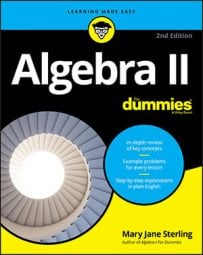When you complete the square on an equation with both x's and y's, the result is a standard form of the equation for a conic section. You can then use this standard form to uncover more information about the conic section.
Conic sections (circles, ellipses, hyperbolas, and parabolas) have standard equations that give you plenty of information about individual curves — where their centers are, which direction they go in, and so on.
For example, you can write the equation x2 + 6x + 2y2 – 8y + 13 = 0 as the sum of two binomials squared and a constant. Think of the equation as having two separate completing-the-square problems to, well, complete. Follow these steps to give the equation a twice-over:
To handle the two completions more efficiently, rewrite the equation with a space between the x terms and the y terms and with the constant on the other side:
x2 + 6x + 2y2 – 8y = –13
You don't divide through by the 2 on the y2 term because that would leave you with a fractional coefficient on the x2 term.
Find any numerical factors for each grouping — you want the coefficient of the squared term to be one. Write the factor outside parentheses with the variables inside.
In this case, you factor the 2 out of the two y terms and leave it outside the parentheses:
x2 + 6x + 2(y2 – 4y) = –13
Complete the square on the x's, and add whatever you used to complete the square to the other side of the equation, too, to keep the equation balanced.
Here, you take half of 6, square the 3 to get 9, and then add 9 to each side of the equation:
x2 + 6x + 9 + 2(y2 – 4y) = –13 + 9
Complete the square on the y's, and add whatever you used to complete the square to the other side of the equation, too.
If the trinomial is inside parentheses, be sure you multiply what you added by the factor outside the parentheses before adding to the other side.
Completing the square on the y's means you need to take half the value (–4), square the –2 to get +4, and then add 2(4) or 8 to each side:
x2 + 6x + 9 + 2(y2 – 4y + 4) = –13 + 9 + 8
Why do you add 8? Because when you put the 4 inside the parentheses with the y's, you multiply by the 2. To keep the equation balanced, you put 4 inside the parentheses and 8 on the other side of the equation.
Simplify each side of the equation by writing the trinomials on the left as binomials squared and by combining the terms on the right.
For this example, you get (x + 3)2 + 2(y – 2)2 = 4.

